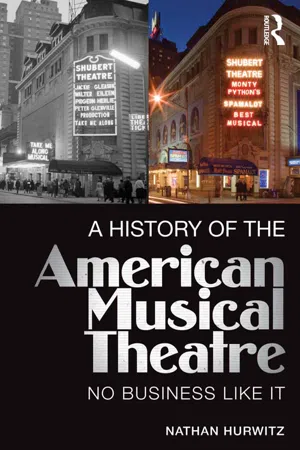
A History of the American Musical Theatre
No Business Like It
- 260 pages
- English
- ePUB (mobile friendly)
- Available on iOS & Android
About this book
From the diverse proto-theatres of the mid-1800s, though the revues of the '20s, the 'true musicals' of the '40s, the politicisation of the '60s and the 'mega-musicals' of the '80s, every era in American musical theatre reflected a unique set of socio-cultural factors.
Nathan Hurwitz uses these factors to explain the output of each decade in turn, showing how the most popular productions spoke directly to the audiences of the time. He explores the function of musical theatre as commerce, tying each big success to the social and economic realities in which it flourished.
This study spans from the earliest spectacles and minstrel shows to contemporary musicals such as Avenue Q and Spiderman. It traces the trends of this most commercial of art forms from the perspective of its audiences, explaining how staying in touch with writers and producers strove to stay in touch with these changing moods. Each chapter deals with a specific decade, introducing the main players, the key productions and the major developments
in musical theatre during that period.
Frequently asked questions
- Essential is ideal for learners and professionals who enjoy exploring a wide range of subjects. Access the Essential Library with 800,000+ trusted titles and best-sellers across business, personal growth, and the humanities. Includes unlimited reading time and Standard Read Aloud voice.
- Complete: Perfect for advanced learners and researchers needing full, unrestricted access. Unlock 1.4M+ books across hundreds of subjects, including academic and specialized titles. The Complete Plan also includes advanced features like Premium Read Aloud and Research Assistant.
Please note we cannot support devices running on iOS 13 and Android 7 or earlier. Learn more about using the app.
Information
Table of contents
- Cover Page
- Half-Title Page
- Title Page
- Copyright Page
- Table of Contents
- List of figures
- Acknowledgements
- Setting the stage
- Prologue
- The first act
- Intermission
- The second act
- Second intermission
- The third act
- Epilogue
- Appendix
- Bibliography
- Index